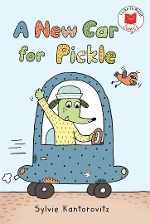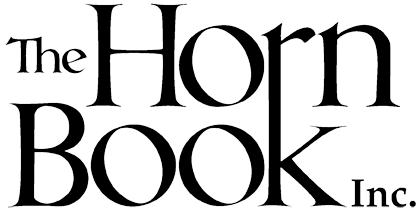Five questions for Sylvie Kantorovitz
Vehicles are a staple of picture books, and Sylvie Kantorovitz’s new early-reader comic A New Car for Pickle (Holiday, 4–8 years), capitalizes on that favorite topic for readers who are speeding toward independence — and with plenty of humor and whimsical panel illustrations, it’s perfect for summer reading. See Kantorovitz’s March/April 2022 Horn Book Magazine article “Graphic Memoirs: Why We Read Them. Why We Need Them” for some thoughts on books those same readers might enjoy further down the road.
Vehicles are a staple of picture books, and Sylvie Kantorovitz’s new early-reader comic A New Car for Pickle (Holiday, 5–8 years), capitalizes on that favorite topic for readers who are speeding toward independence — and with plenty of humor and whimsical panel illustrations, it’s perfect for summer reading. See Kantorovitz’s March/April 2022 Horn Book Magazine article “Graphic Memoirs: Why We Read Them. Why We Need Them” for some thoughts on books those same readers might enjoy further down the road.
1. How is working on an early-reader comic (A New Car for Pickle; Monti and Leo) similar to working on a graphic memoir for older readers (Sylvie)? How is it different?
 |
| Photo: Barbara Lehman. |
Sylvie Kantorovitz: The obvious similarity is that they rely on visual storytelling and require the drawing of lots of mini-pictures. With early-reader comics, I always aim for the same thing: readability. I try to keep my panels simple, clear, uncluttered.
There is an aspect that contains both similarities and differences: the three books you mention all present situations familiar to children, such as new friendships, facing problems, making choices. What is different is that they are created for readers with different levels of life experience.
My early readers present ideas familiar to children who are almost new to the world outside of home, who often face situations for the first time: starting a friendship, feeling unwelcome, defending a friend (as in Monti and Leo), making choices by trial and error (as in A New Car for Pickle). My graphic memoir deals with very much the same subjects but assumes a different level of experience from readers in navigating their own family, friends, and school, in facing their own difficulties and solving their problems. The content is therefore more complex; the problems and their resolutions are more nuanced.
Another big difference has to do with using my imagination versus using my memories. For my early readers, I wanted to create cozy settings busy with animal characters, which have the extraordinary advantage of being like children but who live on their own in a small village. I gave my little characters conflicts and problems that needed solving. And then, I decided on a resolution that felt emotionally satisfying to me. For Sylvie, I drew on my memories of growing up in France, on my relationships with my parents, my siblings, my friends, on my school and my teachers, on my worries about the future, and on my love of drawing. The story already existed, I just had to extract it from the jumble of images in my mind.
2. What’s your process for pacing a comic?
SK: First, I write a story line followed by more detailed content of the story. At that point my work probably resembles the writing of a play. I also draw pages of character studies, and I experiment with style.
For each one of my books, I make a page grid that shows the various possible panel sizes and page layouts. With Sylvie, I allowed myself to go to a maximum of nine panels in one page. For my early readers it is four panels per page, six on rare occasions. The grid is only a guide, and I alter as needed.
Once I have the content and grid, I cut and paste the text and position it inside panels. I include a quick description of what the image contains. This pacing stage involves a lot of cutting, pasting, juggling, shuffling, recutting, and re-positioning. If I were to draw myself at this stage, I would be surrounded by a whirlwind of notes, Post-its, scissors, tape, and sweat beads.
The task of deciding what to put in each panel and choosing the panel size is entirely intuitive. Maybe because I grew up in France and loved reading comics, this process of pacing feels very natural to me. And then, I start sketching.
 3. What books did you like when you were first learning to read?
3. What books did you like when you were first learning to read?
SK: I remember piles of Little Golden Books (Les petits livres d’or). I remember heavy books of fairy tales, two of them Grimms’ and one of Scandinavian tales, beautifully illustrated. I remember “The Snow Queen” and a series of thick Disney compilations. I read and re-read them all. I also read favorite comics, from Mickey Mouse Magazine to the more elaborate Tintin, Asterix, and many more.
I loved to read. Both my parents were big readers, and we had books just like we had pajamas or shampoo. I had two older cousins, and I think a lot of their books made it onto our shelves. I just read what was around, and I think I loved it all.
I clearly remember the delight of facing an afternoon of (hopefully) uninterrupted reading, of sitting down on the carpet, with a pile of books by my side with the shortest on top and going down to the longest. I knew I could read them all, methodically, one after the other, but enjoyed the warming up and the feeling of accomplishment generated by the easier start.
4. How are you like Pickle?
SK: I would love to be as carefree as Pickle. But I think I am fairly good-natured like him. I do favor a very simple way of life, and when choosing a new car, I also looked for small, simple, and safe. Like Pickle, I can get frustrated when a machine of any kind stops working. But, really, who doesn’t? And I am also very fond of whipped cream!
5. Which Richard Scarry car would Pickle pick — the pickle, the apple, or the banana car — and why?
SK: Of course Pickle would choose the Pickle car! How could he not? A Pickle Car for Pickle? Irresistible!
But then, he might get rained on, get cold and soaked, and realize the apple car was the smarter choice: cozy, warm, and dry. The good thing is, Pickle always gets a second chance.
From the April 2024 issue of Notes from the Horn Book: Summer Reading. For past years’ summer reading lists from The Horn Book, click on the tag summer reading.
RELATED
ALREADY A SUBSCRIBER? LOG IN
We are currently offering this content for free. Sign up now to activate your personal profile, where you can save articles for future viewing.







Add Comment :-
Comment Policy:
Comment should not be empty !!!